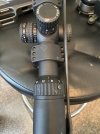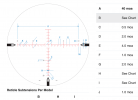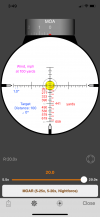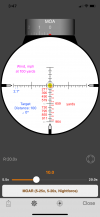DartonJager
Well-Known Member
- Joined
- Apr 1, 2016
- Messages
- 976
I have given FFP scopes a good enough try to know they will not work for my style of hunting and the conditions I hunt in 60-70% of the time if not more. A fellow member of my rifle club allowed me to barrow not one but two FFP scopes for me to take home and try out one a MIL Dot WGS and one a Bushnell with I think was a G3? reticle and I absolutely did not like how the reticle looked at lowest power settings and in low light and also in the thick cover in low light I hunt in at least 50% of the time. I will be staying with SFP scopes for now.
I felt I should add my scopes are normally kept at their lowest setting at all times and are used at their lowest setting to make best guess 90-95% of all the shots I have ever taken on deer or elk because I have always been fortunate enough to get close enough that I need not dial up the power on my scope beyond minimum setting. Another reason why I do not like FFP scopes.
I felt I should also add my desirer to become proficient at longer ranges of up to 700 yards is because of two experiences on my last elk hunting trip First one was I spotted a pretty good bull with about 1 hr. of daylight left was beyond the max effective range of my Bushnell LRF so he was way past 1k yards. I gave it my absolute all out do or die effort to close the distance but unfortunately I couldn't get any closer than about around 600-650 yards as my LRF an older Bushnell was having some difficulty giving an exact reading. I sat and watched that bull a beautiful 6x6 bugle and tend his Harim of 7-8 cows until I lost my light. My rifle at that time had a VariX-III 4-12x40 and no way I could make that shot work.
A few days later I found myself below an elk heading up a mountain to the tree line to bed and again **** near gave myself a heart attack trying to close to my effective range of 400 or so yards only to watch him vanish into the trees at about 500-550 yards from me. That was my first elk trip I went home without killing a bull.
Since then I have promised myself my next elk trip if my skills allowed that I would be able to at least make a 600 yard shot if conditions were favorable and I would be equipped with a scope capable of making such shots. I already own several rifles in calibers more than capable to cleanly kill an elk or deer at 600 yards. Now all I need is the skills and the correct scope for the job. And i have to buy the scope to be able to gain the skills.
That said I had posted a request for help in choosing between two scopes and a V4 and a VX5 with nearly identical reticles that featured simple hash marks on the majority of both the vertical and horizontal parts of the reticle.
So I now need some help from experienced long range hunters who use SFP scopes with the type of reticle(s) (I have included a LINK to picture of the reticle) , to if you will clear the air and separate what I have read and based my assumptions on from the real world facts about SFP scopes and tactical types of reticles. So here is my situation.
A member here replied and advised me that because they are SFP scopes such reticles featuring multiple hash marks is not really useful in a hunting application due to the fact to use them in a SFP scope you MUST be at or near the scopes highest magnification as predetermined by the manufacturer, a fact I was and are very well aware of with SFP scopes. And I would be better served with a standard reticle devoid of any hash marks along the lines of a duplex.
I had to admit he caused me to realize I was basing my choice of reticle types on only what I had read by others and not considered if it would actually work for me as I assumed it would. I bought into the concept of spending the time shooting to determine the drop of my reloads at all distances out to XXX yards and then determine how the hash marks and their sub tensions correlated to my reloads performance while the scope was set to the power setting required to do so.
Part of why I was convinced the SFP scope would work as I described above was I always do any longer shooting with the scope set at its max power and I know to take longer shots beyond 250-300 yards you need to get properly set up to do so and that takes time. Although if given the choice I would not and would much prefer to use any kind of a improvised rest but I can and have made more than a few successful shots while standing W/WO sticks, sitting W/WO sticks and kneeling W/WO sticks out to honest LRF confirmed 300 yards but beyond that I would have to get properly set up shooting either from a naturally occurring rest of some kind or prone.
All of which takes time and I feel it is realistic to believe I would have time to set my scope at the correct magnification, after all I have to set it to the correct magnification setting to use the dials in the first place so someone (and I mean this sincerely) please educate me as to how I wouldn't also be able to use the hash marks effectively and if need be the hash marks to aid in aiming if I didn't have time to dial as all the factors that affect bullet flight like altitude, atmospheric conditions, wind, angle etc that will dictate how much I dial for drop or wind should again unless I am wrong here equally affect the application of the hash marks for adjusting for wind and drop as well, or am I wrong?
So am I pipe dreaming here or are my expectations and assumptions realistic in a day in day out hunting situation?
So what I would greatly appreciate is input from those who transitioned from standard SFP non tactual adjustable turret scopes not designed for in the field adjusting wind and elevation to SFP scopes that are equipped with exposed turrets for dialing for wind and elevation adjustments what reticles they use and why and especially if they at one time used a reticle like the the ones I am considering that I have included a link to a picture of and went back to a standard duplex or similar reticle design and why.
Link to reticle example:
I felt I should add my scopes are normally kept at their lowest setting at all times and are used at their lowest setting to make best guess 90-95% of all the shots I have ever taken on deer or elk because I have always been fortunate enough to get close enough that I need not dial up the power on my scope beyond minimum setting. Another reason why I do not like FFP scopes.
I felt I should also add my desirer to become proficient at longer ranges of up to 700 yards is because of two experiences on my last elk hunting trip First one was I spotted a pretty good bull with about 1 hr. of daylight left was beyond the max effective range of my Bushnell LRF so he was way past 1k yards. I gave it my absolute all out do or die effort to close the distance but unfortunately I couldn't get any closer than about around 600-650 yards as my LRF an older Bushnell was having some difficulty giving an exact reading. I sat and watched that bull a beautiful 6x6 bugle and tend his Harim of 7-8 cows until I lost my light. My rifle at that time had a VariX-III 4-12x40 and no way I could make that shot work.
A few days later I found myself below an elk heading up a mountain to the tree line to bed and again **** near gave myself a heart attack trying to close to my effective range of 400 or so yards only to watch him vanish into the trees at about 500-550 yards from me. That was my first elk trip I went home without killing a bull.
Since then I have promised myself my next elk trip if my skills allowed that I would be able to at least make a 600 yard shot if conditions were favorable and I would be equipped with a scope capable of making such shots. I already own several rifles in calibers more than capable to cleanly kill an elk or deer at 600 yards. Now all I need is the skills and the correct scope for the job. And i have to buy the scope to be able to gain the skills.
That said I had posted a request for help in choosing between two scopes and a V4 and a VX5 with nearly identical reticles that featured simple hash marks on the majority of both the vertical and horizontal parts of the reticle.
So I now need some help from experienced long range hunters who use SFP scopes with the type of reticle(s) (I have included a LINK to picture of the reticle) , to if you will clear the air and separate what I have read and based my assumptions on from the real world facts about SFP scopes and tactical types of reticles. So here is my situation.
A member here replied and advised me that because they are SFP scopes such reticles featuring multiple hash marks is not really useful in a hunting application due to the fact to use them in a SFP scope you MUST be at or near the scopes highest magnification as predetermined by the manufacturer, a fact I was and are very well aware of with SFP scopes. And I would be better served with a standard reticle devoid of any hash marks along the lines of a duplex.
I had to admit he caused me to realize I was basing my choice of reticle types on only what I had read by others and not considered if it would actually work for me as I assumed it would. I bought into the concept of spending the time shooting to determine the drop of my reloads at all distances out to XXX yards and then determine how the hash marks and their sub tensions correlated to my reloads performance while the scope was set to the power setting required to do so.
Part of why I was convinced the SFP scope would work as I described above was I always do any longer shooting with the scope set at its max power and I know to take longer shots beyond 250-300 yards you need to get properly set up to do so and that takes time. Although if given the choice I would not and would much prefer to use any kind of a improvised rest but I can and have made more than a few successful shots while standing W/WO sticks, sitting W/WO sticks and kneeling W/WO sticks out to honest LRF confirmed 300 yards but beyond that I would have to get properly set up shooting either from a naturally occurring rest of some kind or prone.
All of which takes time and I feel it is realistic to believe I would have time to set my scope at the correct magnification, after all I have to set it to the correct magnification setting to use the dials in the first place so someone (and I mean this sincerely) please educate me as to how I wouldn't also be able to use the hash marks effectively and if need be the hash marks to aid in aiming if I didn't have time to dial as all the factors that affect bullet flight like altitude, atmospheric conditions, wind, angle etc that will dictate how much I dial for drop or wind should again unless I am wrong here equally affect the application of the hash marks for adjusting for wind and drop as well, or am I wrong?
So am I pipe dreaming here or are my expectations and assumptions realistic in a day in day out hunting situation?
So what I would greatly appreciate is input from those who transitioned from standard SFP non tactual adjustable turret scopes not designed for in the field adjusting wind and elevation to SFP scopes that are equipped with exposed turrets for dialing for wind and elevation adjustments what reticles they use and why and especially if they at one time used a reticle like the the ones I am considering that I have included a link to a picture of and went back to a standard duplex or similar reticle design and why.
Link to reticle example:
Last edited:




